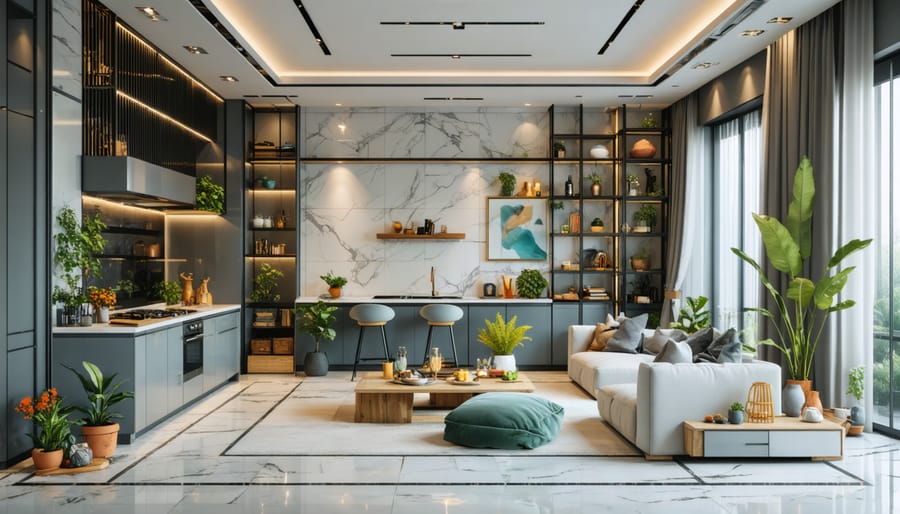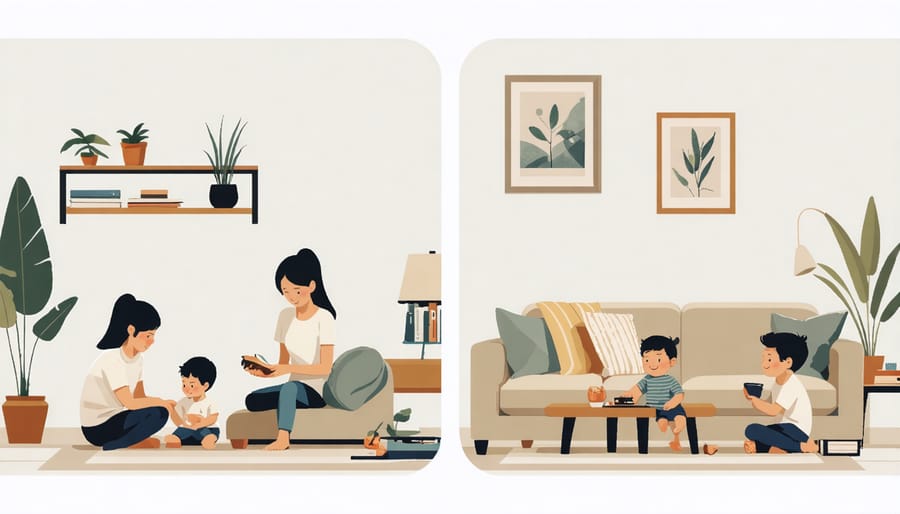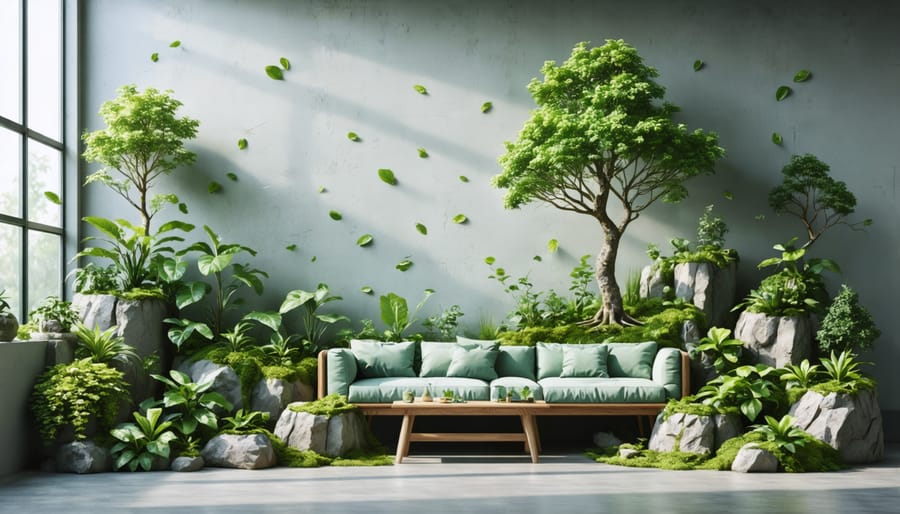
These Designer Questions Will Create Your Dream Home (Without the Guesswork)
Transform your initial client consultation into a strategic foundation for design success by mastering the art of the interior design client questionnaire. The right questions unlock crucial insights about lifestyle needs, aesthetic preferences, and practical constraints that shape exceptional design outcomes.
Strategic questioning creates the roadmap for every successful interior design project. By diving deep into clients’ daily routines, understanding their vision, and uncovering potential challenges early, designers can avoid costly revisions and deliver spaces that truly transform how people live. Whether you’re a seasoned professional or new to client consultations, asking thoughtful, targeted questions demonstrates expertise while building the trust essential for collaborative design relationships.
The most impactful questions go beyond basic style preferences to explore functionality, maintenance requirements, and long-term adaptability. They reveal not just what clients want their space to look like, but how they need it to work for their unique lifestyle. This comprehensive approach ensures designs that are both beautiful and livable, setting the foundation for projects that exceed expectations and create lasting client satisfaction.
Lifestyle and Functionality Questions
Daily Routines and Activities
Understanding how clients live their daily lives is crucial for creating functional and personalized spaces. Start by asking about their typical weekday routine, including wake-up times, meal preparation habits, and evening activities. This information helps determine optimal lighting placement and space allocation for different times of the day.
Inquire about weekend patterns too: “How do you typically spend your weekends at home?” Some families host regular gatherings, while others prefer quiet relaxation. These details influence furniture arrangement and storage needs.
Ask specific questions about entertainment preferences: “Do you watch TV as a family? Where do you prefer to read or work on laptops?” This helps determine appropriate seating arrangements and electrical outlet placement.
For families with children, discuss homework routines, play areas, and storage needs for toys and school supplies. If pets are part of the family, ask about their habits and requirements for beds, feeding stations, or outdoor access.
Don’t forget to ask about special activities or hobbies: “Do you work from home? Do you exercise indoors? Do you need space for crafts or hobbies?” These activities might require dedicated areas or flexible spaces that serve multiple purposes.
Finally, discuss cleaning and maintenance routines. Understanding how clients maintain their space helps in selecting appropriate materials and creating storage solutions that support their lifestyle while keeping the home organized and functional.

Special Requirements and Accessibility
Understanding special requirements and accessibility needs is crucial for creating a truly functional and inclusive design. Start by asking about any mobility concerns: “Does anyone in the household use mobility aids or have specific accessibility requirements?” This helps plan for wider doorways, ramps, or grab bars where needed.
For households with pets, inquire about their daily routines and needs: “What kind of pet accommodations would make life easier?” Consider dedicated feeding stations, pet-friendly materials, or built-in beds. Ask about storage needs for pet supplies and grooming equipment.
Child safety is another vital consideration. If there are children in the home, ask: “What safety features are most important to you?” This might lead to discussions about rounded corners, childproof storage, or durable, easy-to-clean materials.
Don’t forget to ask about current or future health considerations: “Are there any health-related modifications we should plan for?” This could include non-slip flooring, enhanced lighting for vision impairment, or allergen-resistant materials.
For aging-in-place designs, consider questions like: “Would you like us to incorporate features that make the space more accessible as you age?” This might involve discussing lower counter heights, easy-to-operate fixtures, or strategic placement of outlets and switches.
Remember to ask about seasonal requirements: “Do any family members have specific needs during different seasons?” This could affect choices in lighting, ventilation, or storage solutions.

Style and Aesthetic Preferences
Design Inspiration Sources
Understanding a client’s design inspiration is crucial during design consultations, as it helps create spaces that truly reflect their vision. Start by asking clients about their favorite spaces, whether it’s a room in their previous home, a hotel they’ve visited, or even a friend’s house. This gives immediate insight into their aesthetic preferences and the feelings they want to evoke in their space.
Request that clients share their Pinterest boards, Instagram saves, or design magazine clippings. These visual references are invaluable for understanding their style preferences and can help avoid miscommunication about design concepts. Ask specific questions about what draws them to certain images – is it the color scheme, the furniture arrangement, or the overall atmosphere?
Explore their lifestyle influences by asking about their favorite restaurants, hotels, or retail spaces. Commercial spaces often inspire unique design elements that can be adapted for residential use. Don’t forget to inquire about their travel experiences, as different cultures and locations can greatly influence design preferences.
Finally, ask about any specific designers, artists, or eras that inspire them. This information can help incorporate subtle nods to their favorite styles while maintaining a cohesive design that works for their space and lifestyle.
Color and Material Preferences
Understanding a client’s color and material preferences is crucial for creating a space that truly resonates with them. Start by asking about their favorite colors and those they absolutely want to avoid. This helps establish a basic palette while preventing potential design mishaps. Follow up with questions about existing pieces they plan to keep, as these often influence the overall color scheme.
Ask clients to share images of spaces they love, paying special attention to the materials and finishes that catch their eye. Do they gravitate toward glossy or matte surfaces? Are they drawn to natural materials like wood and stone, or do they prefer modern materials like glass and metal? Understanding their texture preferences is equally important – some clients love plush, soft surfaces while others prefer sleek, smooth ones.
Consider asking about their maintenance preferences too. Some materials and finishes require more upkeep than others, so it’s essential to align these choices with the client’s lifestyle. For instance, a busy family might prefer durable, easy-to-clean surfaces over delicate, high-maintenance materials.
Don’t forget to discuss how different lighting conditions might affect color choices. Ask about the room’s natural light exposure and their preferred artificial lighting style, as these factors significantly impact how colors appear throughout the day. Finally, inquire about any cultural or personal significance certain colors might hold for them, as this can add meaningful depth to your design choices.
Budget and Timeline Considerations
Investment Priorities
Understanding where clients want to invest their money is crucial for creating a design that meets both their desires and practical needs. Start by asking about their overall budget range and whether it’s flexible. Follow up with questions like “Which elements of the design are most important to you?” and “What features do you consider absolute must-haves?”
It’s helpful to have clients rank their priorities, such as furniture quality, custom pieces, lighting fixtures, or window treatments. Ask them to identify areas where they’re willing to splurge versus save. For example, some clients might prioritize a luxury sofa but be content with more affordable accent pieces.
Consider asking: “Are there any existing pieces you’d like to keep and work around?” This helps allocate the budget more effectively. Also important is understanding their timeline for purchases – whether they prefer to invest in everything at once or phase the project over time.
Don’t forget to discuss potential unexpected costs and whether they’d like to set aside a contingency budget for unforeseen expenses or design opportunities that may arise during the project.
Project Timing and Phases
Understanding your client’s timeline expectations is crucial for project success. Start by asking when they’d like the project completed and if there are any specific events or deadlines driving their timeline. For renovation projects, use our comprehensive project planning template to break down the phases.
Key timing questions to ask:
– When would you like to begin the project?
– Are there any important dates we need to work around (holidays, special events, etc.)?
– How flexible is your timeline?
– Will you be living in the space during renovations?
– Do you prefer work to be done during specific hours?
– Are you planning any travel that might affect the project schedule?
Be sure to discuss potential delays due to material delivery times, contractor availability, or permit processing. Setting realistic expectations about project duration helps avoid misunderstandings and ensures smoother project execution. Remember to factor in time for design revisions, furniture delivery, and final styling touches.
Future-Proofing and Sustainability
Long-term Living Plans
Understanding a client’s long-term living plans is crucial for creating spaces that remain functional and beautiful for years to come. Smart designers always ask about future family changes, such as planning for children, accommodating aging parents, or preparing for retirement. These conversations help determine how flexible and adaptable the design needs to be.
Key questions should explore whether clients plan to age in place, requiring considerations for future mobility needs like wider doorways or single-floor living arrangements. It’s also important to discuss potential home-based businesses, hobby spaces, or workout areas that might need to be incorporated later.
Ask about their five to ten-year vision for the space. Will they need to convert a home office into a nursery? Could a playroom eventually become a teenager’s study area? Understanding these potential transitions helps in selecting versatile furniture and creating multipurpose spaces that can evolve with the family’s needs.
Don’t forget to inquire about possible technological upgrades they might want to incorporate in the future. This could influence decisions about electrical planning and smart home integration. Also, discuss their expectations about maintenance and durability – some clients may prefer materials and finishes that are easier to update as their needs change.
Remember to ask about any family heirlooms or cherished pieces they plan to inherit, as these items should be factored into the long-term design strategy.

Eco-friendly Preferences
Understanding your client’s commitment to sustainability and environmental consciousness is crucial for creating spaces that align with their values. Consider asking these key questions to gauge their eco-friendly preferences:
How important is environmental sustainability in your design choices? This helps establish the priority level for eco-friendly design solutions and determines the budget allocation for sustainable materials.
Are you interested in energy-efficient lighting and appliances? This reveals their willingness to invest in long-term energy savings through LED fixtures, smart thermostats, and energy-star rated appliances.
What are your thoughts on recycled or reclaimed materials? Understanding their openness to using repurposed items, vintage pieces, or materials made from recycled content helps shape material selection.
How do you feel about natural or organic materials? This explores their interest in bamboo flooring, organic fabrics, low-VOC paints, and other natural alternatives.
Would you like to incorporate water-saving fixtures? Their response guides choices for bathroom and kitchen fixtures that conserve water while maintaining functionality.
Are you interested in incorporating indoor plants or living walls? This reveals their desire to improve indoor air quality and create connections with nature through biophilic design elements.
What are your thoughts on sustainable furniture manufacturers? Understanding their stance on supporting eco-conscious brands helps guide furniture selection and sourcing decisions.
Asking the right questions during client consultations is the cornerstone of successful interior design projects. These carefully crafted questions help designers build a comprehensive understanding of their clients’ needs, preferences, and lifestyle – essential elements that transform good designs into exceptional ones.
By thoroughly exploring practical considerations like budget, timeline, and space functionality, designers can avoid potential roadblocks and create realistic project plans. Meanwhile, questions about style preferences, color choices, and personal taste help bridge the gap between the client’s vision and the designer’s expertise, ensuring the final result truly reflects the client’s personality while maintaining professional design standards.
Remember that these questions aren’t just about gathering information – they’re about building trust and establishing a strong working relationship. When clients feel heard and understood, they’re more likely to be confident in the design process and satisfied with the final results.
After completing your initial client questionnaire, the next steps typically involve:
– Creating a detailed project brief based on the gathered information
– Developing preliminary design concepts
– Setting up a follow-up meeting to review initial ideas
– Establishing a clear timeline and communication plan
– Beginning the space planning and material selection process
Keep in mind that client questioning isn’t a one-time event. Successful designers maintain open communication throughout the project, regularly checking in with clients to ensure the design direction remains aligned with their vision and needs. This ongoing dialogue helps prevent misunderstandings and allows for timely adjustments as the project evolves.
By investing time in thorough client questioning at the start and maintaining clear communication throughout, designers can create spaces that not only look beautiful but truly enhance their clients’ daily lives. This attention to detail and client-focused approach is what sets exceptional interior designers apart and leads to long-lasting client relationships and successful project outcomes.
